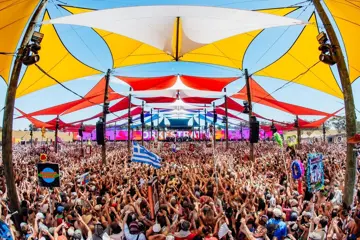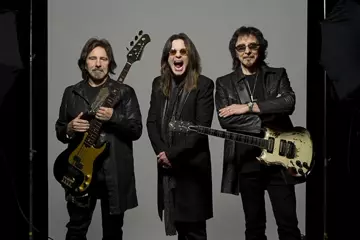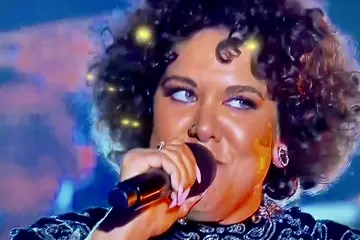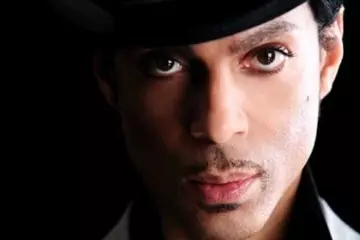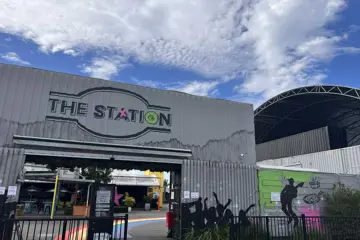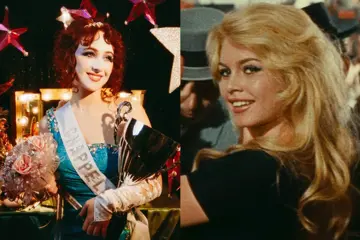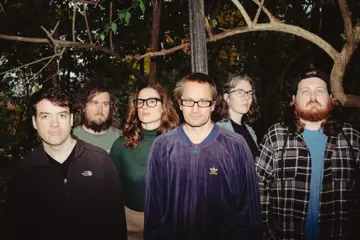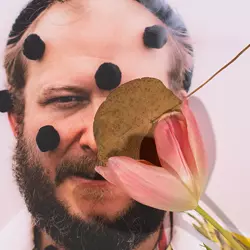 Bon Iver
Bon IverWith the release of Bon Iver’s SABLE, fABLE, the fifth album —and first in six years— for Justin Vernon’s hugely influential project, the kind of ‘brand activation’ normally synonymous with luxury goods has been taking place around Australia.
Riffing off the album’s ultra-minimalist, salmon-and-black artwork, various bespoke food and drink items are popping up around notable Australian eateries, seeking the kind of social content and influencer engagement befitting a pop star.
Vernon is almost that, but not quite. Though he found fame —and achieved peak one-sheet narrative— by recording his debut LP, 2007’s For Emma, Forever Ago, as a man alone in a cabin, in the years since, he’s won Grammy Awards, gone platinum, played stadiums, collaborated with Taylor Swift and Charli XCX, among others.
But for all the flannel-shirt lore attached to his debut, there were signs from the start of the kind of progressive production and experimental arrangements Bon Iver would grow to employ. And, on SABLE, fABLE, there are tunes that feel very much in conversation with Bon Iver’s beginnings and the notion of Vernon as a folk musician.
Don't miss a beat with our FREE daily newsletter
The album serves as a continuation of the 2024 EP SABLE. Three of that EP’s songs sit as the first three tracks on SABLE, fABLE, creating a conversation with both the recent Bon Iver past and the discography prior.
SABLE, fABLE is billed as the ‘full book’ following on from SABLE’s initial epilogue (continuing, and perhaps confusing, the literary designations, the first song on SABLE, fABLE not taken from the EP is called Short Story).
But, hearing the familiar songs from the EP here, there’s a sense that they always marked a new beginning, the start of something, with the lingering comma left in the EP’s title feeling like it was always holding a space, suggesting more to come (Vernon’s use of erratic use of capitalisation and alt characters has turned tracklists into typographical art).
Upon its release, SABLE was called “a retreat and reset” in the record bio; the radically stripped-back arrangements returning Bon Iver to something that sounded, and felt, like the beginning.
Speyside is set around the simplicity of an acoustic guitar and a lyrical bloodletting, the song beginning with Vernon signing “I know now that I can’t make good/How I wish I could”, his words front and centre.
The notion of a man alone in the spotlight is amplified on Awards Season, whose verses find Vernon singing largely unaccompanied, over an ambient hum; this punctuated only by a brief flurry of woodwinds.
Both its stripped-back nature and the outburst of horns summon For Emma, Forever Ago, an album whose essential title track, For Emma, is filled with warm horns, as trombone and trumpet layered into a bright brass section that feels like it’s lifting the songs.
The presence of additional players —John Dehaven and Randy Pingrey— showed that the man alone in the woods wasn’t entirely alone. But the epic The Wolves (Act I and II), which sat at the centre of For Emma, pointed toward where Vernon would head: its employment of tremoring autotuned vocals and splattered percussion, each as deftly placed arrangement element, suggested a future in which Vernon would use digital effects as expressive tools, the studio ‘as instrument’.
His second album, 2011’s Bon Iver, Bon Iver, took that sound more widescreen, swelling to fill the festivals and large-scale venues that were now Vernon’s home. But on its release, it was most notable for the daring of Beth/Rest, an ’80s-coded soft-rock ballad whose open evocation of adult-contempo songwriter Bruce Hornsby was an act of uncool reclamation that eventually turned full circle when Vernon collaborated with Hornsby on his 2019 single Cast Off.
2016’s 22, A Million and 2019’s i,i each took Bon Iver into more complex and shapeshifting modes of production and song-assembly, situating voice at their centre yet being unafraid of using extreme digital effects, or jostling the listener with unexpected arrangements and radical shifts.
Those approaches remain on SABLE, fABLE, a record which, in many ways, draws connections to all of the Bon Iver back catalogue. If its EP table-setter was a stripped-down valentine to isolation that harkened back to the project’s beginnings, the grandeur of the rest of the record, its extensive use of saxophone and pedal steel (which Vernon was called “the most beautiful musical instrument that humans have constructed”), keep the sound familiar and build on from what’s come before.
‘70s blue-eyed soul and ‘80s quiet storm slow-jams seem the obvious reference points for inspirations. These are familiar totems for Vernon, but the new album leans into those influences more directly, with less cloaking and complicating than before, on songs like Everything Is Peaceful Love, I’ll Be There, and Walk Home, all of which throb with desire.
These jams, a little unexpectedly, are reminiscent of Gayngs, the short-lived soft-rock big-band whose sole album, 2010’s Relayted, featured Vernon throughout and mined old AM-radio sounds with a playful sense of sleaze and a questionable sense of sincerity. A Bon Iver record will never be questioned for its sincerity, but there is a notable shift in hearing the songs sound horny, sweaty, jammy, and vibey.
There’s something more relaxed about how SABLE, fABLE feels. In the title/s of the EP and LP, Vernon has summoned SABLE not as the adorable woodland marten, but as a colour; its black conveying darkness and mourning. But if the initial EP reset felt as if it was still inhabiting that darkness, the LP that’s grown out of it is filled with a surprising amount of lightness, a sense of happy-to-be-alive joy.
The record has been positioned as a portrait of new love, or at least infatuation; from its heady thrills to its disconcerting instability. It’s also about coming out of the other side, when the initial excitement peters out, realities have set in. And, the eventual acceptance for what’s gone, and appreciation for what was. “A fable isn’t a fairytale,” the album bio warns.
This emotional arc is all contained in the album’s final single, penultimate cut, and essential culmination, There’s A Rhythmn [sic]. It leans on quiet storm and ’90s hip-hop ballads, and is most striking for its simple, direct lyrics. Vernon may not be a pop star, as such, but this is a tune whose melody and clarity feel pop; a gorgeous slow jam from an artist operating with true command of his craft.
SABLE, fABLE is out now via Jagjaguwar. You can listen/buy the album here.








